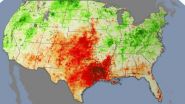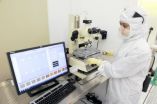(Press-News.org) The United States could eliminate the need for crude oil by using a combination of coal, natural gas and non-food crops to make synthetic fuel, a team of Princeton researchers has found.
Besides economic and national security benefits, the plan has potential environmental advantages. Because plants absorb carbon dioxide to grow, the United States could cut vehicle greenhouse emissions by as much as 50 percent in the next several decades using non-food crops to create liquid fuels, the researchers said.
Synthetic fuels would be an easy fit for the transportation system because they could be used directly in automobile engines and are almost identical to fuels refined from crude oil. That sets them apart from currently available biofuels, such as ethanol, which have to be mixed with gas or require special engines.
In a series of scholarly articles over the past year, a team led by Christodoulos Floudas, a professor of chemical and biological engineering at Princeton, evaluated scenarios in which the United States could power its vehicles with synthetic fuels rather than relying on oil. Floudas' team also analyzed the impact that synthetic fuel plants were likely to have on local areas and identified locations that would not overtax regional electric grids or water supplies.
"The goal is to produce sufficient fuel and also to cut CO2 emissions, or the equivalent, by 50 percent," said Floudas, the Stephen C. Macaleer '63 Professor in Engineering and Applied Science. "The question was not only can it be done, but also can it be done in an economically attractive way. The answer is affirmative in both cases."
Accomplishing this would not be easy or quick, Floudas said. A realistic approach would call for a gradual implementation of synthetic fuel technology, and Floudas estimated it would take 30 to 40 years for the United States to fully adopt synthetic fuel. It also would not be cheap. He estimates the price tag at roughly $1.1 trillion for the entire system.
The research makes up an important part of a white paper recently produced by the American Institute of Chemical Engineers (AIChE), the nation's largest chemical engineering association. In the paper, the chemical engineers call for a greater integration of energy sources and urge policymakers to consider chemical conversion processes as a potential method to produce cleaner and cheaper fuels.
"Right now we are going down so many energy paths," said June Wispelwey, the institute's director and a 1981 Princeton alumna. "There are ways for the system to be more integrated and much more efficient."
The paper was written by Vern Weekman, one of Floudas' co-researchers. Weekman, a lecturer at Princeton, is the former director of the Mobil Central Research Laboratories and a past president of AIChE.
Weekman said the main reason the industry has not embraced synthetic fuels has been cost. Although he said the economics are "still on the edge," Weekman noted that rising prices for crude oil and improvements in the efficiency of synthetic fuel production have made the process far more viable than before.
"The main reason we wrote the paper was to get the planning agencies — the national academies, the Department of Energy, the Environmental Protection Agency, the Defense Department — thinking about this," Weekman said. He added that it was important that the agencies consider "this key link of using chemical processes to produce conventional fuels."
In the Princeton research, Floudas' team found that synthetic fuel plants could produce gasoline, diesel and aviation fuels at competitive prices, depending on the price of crude oil and the type of feedstock used to create the synthetic fuel. About two-thirds of crude oil consumed by the United States is used for transportation fuel, according to the federal Energy Information Administration (EIA). The EIA said the United States imports about 45 percent of its annual crude oil consumption.
"Even including the capital costs, synthetic fuels can still be profitable," said Richard Baliban, a chemical and biological engineering graduate student who graduated in 2012 and was the lead author on several of the team's papers. "As long as crude oil is between $60 and $100 per barrel, these processes are competitive depending on the feedstock," he said.
The core of the plan is a technique that uses heat and chemistry to create gasoline and other liquid fuels from high-carbon feedstock ranging from coal to switchgrass, a native North American grass common to the Great Plains. The method, called the Fischer-Tropsch process, was developed in Germany in the 1920s as a way to convert coal to liquid fuels.
The chemistry is complicated, but it basically takes the carbon and hydrogen from the feedstock and reassembles them into the complex chains that make up fuels like gasoline and diesel. Essentially, the feedstock material is heated to 1,000 to 1,300 degrees Celsius and converted to gas, and using the Fischer-Tropsch process, the gas is converted to chains of hydrocarbon molecules. These hydrocarbon chains are then processed over catalysts such as nickel or iron. The end products include fuels, waxes and lubricants normally made from crude oil.
The Princeton team's method adds a step to recycle CO2 through the process to reduce the amount of the gas vented by the plants. Baliban said there is a limit to how much CO2 can be economically recycled, although plants could also trap unused CO2 emissions for later storage.
Over the years, engineers have refined the original Fischer-Tropsch method to increase efficiency. But the high cost of building new synthetic fuel plants, coupled with the low price of crude oil, has made synthetic fuels too expensive for widespread acceptance.
As the price of oil has increased, however, synthetic fuels have become more practical. The U.S. government has undertaken a number of projects to look into the process; in particular, the Defense Department has studied synthetic fuels as a way to supply transportation fuel without depending on overseas suppliers.
In its work, the Princeton team looked at a broader picture. In a July article in the AIChE Journal, the team found that the United States could meet its entire demand for transportation fuel by building 130 synthetic fuel plants across the country. The article, with Josephine Elia, a graduate student in chemical and biological engineering as the lead author, made its assessment using three feedstocks: coal, natural gas and biomass. To avoid switching farmland from food production to crops used for fuel production — which would hurt the food supply — the researchers only included non-edible crops such as perennial grasses, agricultural residue and forest residue.
The plants modeled in their scenario were placed in proximity to both feedstock supplies and markets for fuels. The analysis factored in external costs such as water supplies and electricity to power the plants' machinery.
Ultimately, the team recommended construction of nine small, 74 medium and 47 large plants producing 1 percent, 28 percent and 71 percent of the fuel, respectively. Most of the plants would be clustered in the central part of the country and in the Southeast. The state with the highest level of fuel production would be Kansas, which would have 11 large synthetic fuel plants. Texas would have the largest number of plants, but because of the scattered nature of feedstock in that state, most of those plants would be medium-sized.
The researchers found that the largest contributor to the price of synthetic fuel would be the cost of building the plants, followed by the purchase of biomass and then electricity. They estimated that the nationwide average cost of producing the synthetic equivalent of a barrel of crude oil would be $95.11, although the cost varies regionally. The cost in Kansas, where most production would occur, would average $83.58 for the equivalent of a barrel of crude oil.
The cost could be much lower if plants eliminated biomass and used only coal and natural gas to run the process, Floudas said, but that would eliminate most of the environmental benefit.
"If you want to have a 50 percent reduction in emissions, you need to have the biomass," he said.
In many ways, synthetic fuels are cleaner than petroleum fuels. The heavy metal and sulfur contaminants of petroleum fuels can be captured in the synthetic plants before the fuel is shipped out. Synthetic fuels also can be used in gasoline and diesel engines with no need for modifications, unlike many biofuels. The biofuel ethanol, for example, is commonly mixed with gasoline, but high levels of ethanol require modifications to car engines and pose special challenges for starting at low temperatures.
Floudas said that synthetic fuels also would allow carbon reduction with the fleet of cars currently on the road. Even if the country immediately converted to zero-emitting electric or fuel cell vehicles, millions of internal combustion vehicles would still be driving. By switching to synthetic fuels, he said, the country would have the opportunity to reduce those emissions, even if it they would not be completely eliminated.
"This is an opportunity to create a new economy," Floudas said. "The amount of petroleum the U.S. imports is very high. What is the price of that? What other resources to do we have? And what can we do about it?"
INFORMATION:
Synthetic fuel could eliminate US need for crude oil
2012-12-06
ELSE PRESS RELEASES FROM THIS DATE:
New '4-D' transistor is preview of future computers
2012-12-06
WEST LAFAYETTE, Ind. – A new type of transistor shaped like a Christmas tree has arrived just in time for the holidays, but the prototype won't be nestled under the tree along with the other gifts.
"It's a preview of things to come in the semiconductor industry," said Peide "Peter" Ye, a professor of electrical and computer engineering at Purdue University.
Researchers from Purdue and Harvard universities created the transistor, which is made from a material that could replace silicon within a decade. Each transistor contains three tiny nanowires made not of silicon, ...
NASA satellites analyze Typhoon Bopha inside and out
2012-12-06
Typhoon Bopha proved deadly to residents in the Mindanao region of the Philippines after ravaging islands in Micronesia. NASA's Aqua and TRMM satellites peered at the storm inside and out, providing forecasters with valuable data as the storm moved into the South China Sea.
On Dec. 5, 2012, Bopha crossed over Palawan and entered the South China Sea after crossing over the southern Philippines' Mindanao region, leaving death and destruction in its wake. According to Reuters news reports on Dec. 5, at least at total of 283 people were killed and hundreds remain missing ...
Plant stress paints early picture of drought
2012-12-06
In July 2012, farmers in the U.S. Midwest and Plains regions watched crops wilt and die after a stretch of unusually low precipitation and high temperatures. Before a lack of rain and record-breaking heat signaled a problem, however, scientists observed another indication of drought in data from NASA and NOAA satellites: plant stress.
Healthy vegetation requires a certain amount of water from the soil every day to stay alive, and when soil moisture falls below adequate levels, plants become stressed. Scientists with the U.S. Department of Agriculture's Agricultural Research ...
NASA investigates use of 'trailblazing' material for new sensors
2012-12-06
Tiny sensors -- made of a potentially trailblazing material just one atom thick and heralded as the "next best thing" since the invention of silicon -- are now being developed to detect trace elements in Earth's upper atmosphere and structural flaws in spacecraft.
Technologist Mahmooda Sultana, who joined NASA's Goddard Space Flight Center in Greenbelt, Md., two years ago and has since emerged as Goddard's go-to expert in the development of graphene-based technology, has expanded her portfolio to include two new research and development efforts aimed at creating nano-sized ...
Site-specific, long-term research expanding understanding of climate change
2012-12-06
DURHAM, N.H., Dec. 5, 2012 – While science has often focused on big-scale, global climate change research, a study recently published in the journal Bioscience suggests that long-term, integrated and site-specific research is needed to understand how climate change affects multiple components of ecosystem structure and function, sometimes in surprising ways.
"Long-term ecological research is important to understanding the effects of a changing climate on our natural resources and so much more," said Michael T. Rains, Director of the Forest Service's Northern Research Station. ...
Experts available to discuss new paper detailing global sea level rise scenario
2012-12-06
On December 6, NOAA will release a technical report that estimates global mean sea level rise over the next century based on a comprehensive synthesis of existing scientific literature. The report finds that there is very high confidence (greater than 90% chance) that global mean sea level will rise at least 8 inches (0.2 meters) and no more than 6.6 feet (2 meters) by 2100, depending upon uncertainties associated with ice sheet loss and ocean warming.
The actual amount of sea level change at any one region and location greatly varies in response to regional and local ...
Biologists unlocking the secrets of plant defenses, 1 piece at a time
2012-12-06
Researchers examining how the hormone jasmonate works to protect plants and promote their growth have revealed how a transcriptional repressor of the jasmonate signaling pathway makes its way into the nucleus of the plant cell.
They hope the recently published discovery will eventually help farmers experience better crop yields with less use of potentially harmful chemicals.
"This is a small piece of a bigger picture, but it is a very important piece," said Maeli Melotto, a University of Texas at Arlington assistant professor of biology.
Melotto recently co-authored ...
Military/Veteran Medical Malpractice Claims Are An Uphill Battle
2012-12-06
Military/Veteran medical malpractice claims are an uphill battle
Some of the highest courts in the land -- the United States Supreme Court among them -- will soon be hearing cases involving the niche area of military malpractice claims. Military physicians usually enjoy "sovereign immunity" (essentially making them immune from many types of lawsuits) in their capacity as physicians working for the government.
These cases do not argue the validity of sovereign immunity, but instead question its applicability in even the most egregious military medical malpractice ...
Could Patient Photos Reduce Serious Medical Errors?
2012-12-06
Could patient photos reduce serious medical errors?
A study by researchers at a Colorado hospital found that including photos in patients' electronic medical records helps reduce serious medical mistakes known as "wrong-patient errors." Implementing electronic record systems with photos at hospitals across the country may help improve the national rate of serious medical errors.
Researchers find using a photo drastically reduces number of errors
In 2009, Children's Hospital Colorado found that misplaced orders in electronic files was the second-most common ...
Potential Pitfalls When Keeping The Home After Divorce
2012-12-06
Potential pitfalls when keeping the home after divorce
One of the most common disagreements among divorcing couples, along with issues of child custody and alimony, is who gets to keep the house. While it is perfectly understandable to be reluctant to give up one's home, people going through divorce should be aware of some hidden costs they may not be expecting if they decide to keep the house.
Maintenance and repair costs
One common unexpected pitfall occurs when the spouse who keeps the home has not accurately estimated the monthly expenses involved in maintaining ...



